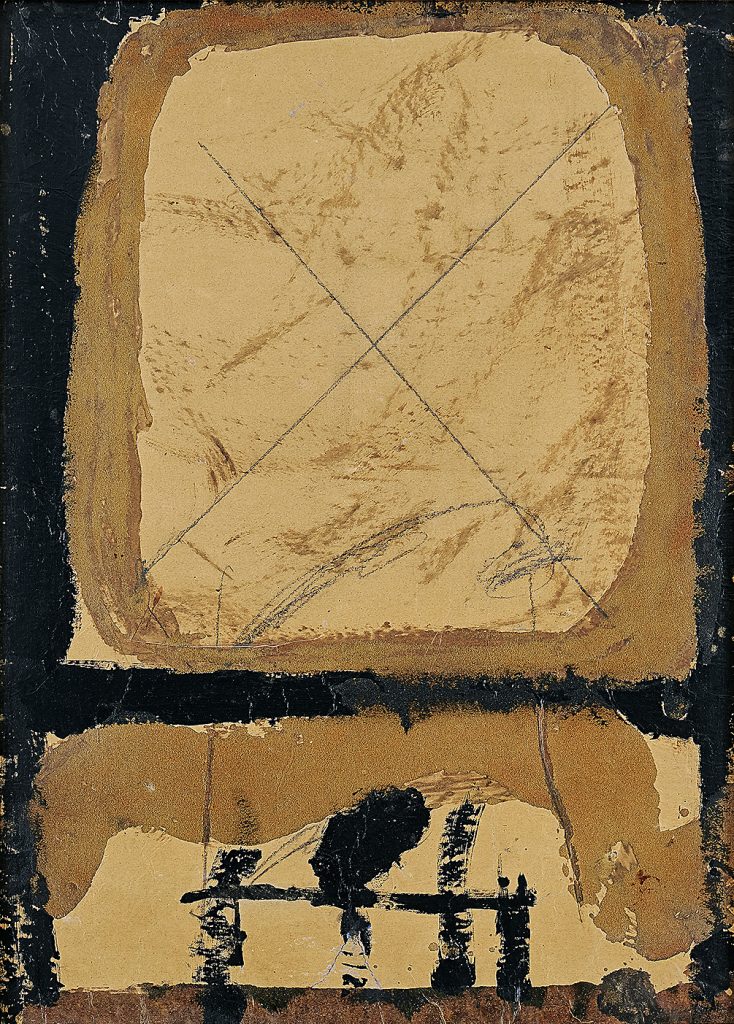“Pintura sobre papel azul” – Antoni Tàpies

380. Antoni Tàpies (Spain 1923‑2012). ”Pintura sobre papel azul”. Mixed media on paper, laid on canvas supported on wood panel, 88 x 64 cm.
SEK 300.000 – 400.000
€ 28.000 – 38.000
Executed in 1964.
Provenance:
Sala Gaspar, Barcelona, 1965.
Bukowskis Auktioner, Stockholm, 23 ‑ 25 November 1988, catalogue 463, lot 420 (illustrated in colours).
A Swedish Private Collection.
Literature:
Anna Agustí, Tàpies, Obra Completa, Volumen 2, 1961‑1968, catalogue no. 1249, illustrated.
Antoni Tàpies is one of the most celebrated and important Spanish artists from the Post-War period, known for his potent visual language using signs, letters and materials in his characterizing artworks. Being brought up in Barcelona, Tàpies’ childhood during the 1930’s was to a great extent influenced by the on-going Spanish Civil War. After attending a law program at a university in Barcelona but without having taken any lessons in painting, he decided to completely devote himself to the arts in 1946. Tàpies remained a self-taught artist throughout his life and the very few lessons he took within artistry made almost no impression on him. Instead he formed his own signature personal style, developed and further explored it over decades but always remained true to the very essence of his artistry.
Tàpies continued the tradition of Spanish abstract painting where signs and symbols are important, as they both explain and proclaim. While examining the very essence of objects and their materials in their own right, Tàpies adds a new dimension of complexity to these objects through powerful signs and symbols, enriching seemingly trivial things. Even in early stages of his artistic process Tàpies showed an interest in collage and graffiti, as well as experimenting in the spirit of Dadaism. In the post-war years he developed a heightened interest in Eastern culture, and it became a fundamental philosophical influence on his work because of its emphasis on the use of different materials. This personal method and expression of his is often seen in relation to the movement matiérisme (matter art) or Art Informel.
Pintura sobre papel azul, created by Tàpies in the year of 1965 and presented in the upcoming sale, is a vivid composition with a distinctive and characteristic cross dominating the mid upper part of the work. This piece is typical those of Antoni Tàpies dating from this period in his life – the artist has collated various mediums together and painted with a restrained palette consisting of colours in black, beige, brown and grey. Letters and signs used in his compositions are references to the real world and symbols of issues, often seen in political contexts. The X as a symbol can be seen in many of Tàpies works and was a crucial and recurring theme for him – a reference to the bold graffiti art sprayed on the walls and facades in his childhood neighbourhood in Barcelona. The people as a protest against the political corrupt system commonly used graffiti as their method of expression, and the X symbolized an anonymous protest. For Tàpies, the cross was also a symbol of liberation from the constraints of religion, and the calligraphic brush strokes lead the viewer’s thoughts to Japanese and Chinese artistic tradition. Having experienced the Spanish Civil War and a ruthless dictatorship, Tàpies artworks dating from the 1960’s and early 1970’s were heavily influenced by his involvement in Spanish and Catalan politics. The violence of the war and the deep scars that it left on the cityscapes and the people of Spain inspired Tàpies to create many of his most interesting and important artworks. They speak of life, experience and humanity from a personal perspective and even though Tàpies might have felt inspired by some of his contemporary artists such as Jasper Johns and Robert Rauschenberg during his exhibitions overseas, his use of elements and subtle details were entirely his own way of expression.
During the late 1950’s and 1960’s, Tàpies’ works were exhibited at numerous important galleries and museums worldwide. In 1962, a few years before he created ”Pintura sobre papel azul”, he was granted a retrospective show at Kestner-Gesellschaft in Hanover, the Solomon R. Guggenheim Museum in New York and the Kunsthaus in Zurich. The attention achieved from the numerous exhibitions shows gave Tàpies an impressive international status in the early 1960’s and a world spanning reputation as an artist, which is as ever present until this day.